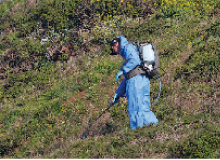Poisoning to create a natural area

Glen Canyon Park is a case in point. Notices were posted of impending pesticide spraying of Garlon 4 Ultra. This park has a constant stream of walkers – adults, children and dogs. A preschool and a summer camp use the park. And there is a natural creek and resident wildlife.
Neighbors, parents, walkers, and dog owners phoned and wrote to the Recreation and Park Department (RPD) to stop the spraying. Despite the protests, RPD plans to continue. The department was able to divert the focus of the concerns away from the use of pesticides by describing it as a “misunderstanding about the notices.”
But there were gross mistakes made by RPD about the notices. The poison was sprayed without actually posting that it had been done; in fact, this was learned from an observer. “Scheduled to be sprayed” continued to appear on the notices, and then it was posted that the spraying had been postponed even though much of the area had already been sprayed. The lack of accuracy in the notices sparked fears from people who, thinking the spraying was still only scheduled, had been walking through the area with their children and dogs.
Glen Canyon Park is included in San Francisco’s Natural Areas Program (NAP) – but there is nothing natural about poisons. The San Francisco Department of the Environment issued NAP a variance to allow the spraying of Garlon Ultra 4, a poison that had not been permitted for use in parks in San Francisco except under extreme and limited circumstances, and then only by dabbing. The variance now allows the spraying of this chemical. Please note the photo of the required safety suit to protect the gardener. The required respirator to protect the gardener is not being worn here, which is in noncompliance.
Garlon Ultra 4’s active ingredient is triclopyr. The Marin Municipal Water Department provides their assessment of this toxic chemical online at www.marinwater.org/documents/Chap4_Triclopyr_8_27_08.pdf. Look at page 12 (labeled 4-9) for information about the increased risks to dogs over other tested mammals.
Roundup is another of the poisonous pesticides currently used in our parks and being considered as a substitute for the Garlon Ultra 4. Scientific American published an article addressing the toxic nature of Roundup’s formula in “Weed-Whacking Herbicide Proves Deadly to Human Cells” (www.scientificamerican.com, search for the column title).
Garlon Ultra 4 and Roundup are not meant to be used in recreational areas.
Exact causal relationships are hard to pinpoint – even linking tobacco and cancer was difficult – but relationships are surfacing. Most cancers have a cumulative variety of causes. The incidence of cancer cases is growing in dogs, and pesticides are included as one of the culprits (www.health-report.co.uk/cancer-pesticides-245T-24D.html). Collateral damage to the environment cannot be discounted, either – long-term effects have not even been examined yet.
The reason poisons are being used in our natural areas is to sustain artificially created landscapes as they might have appeared in the year 1776 – “museumscapes” of fragile native plants. But we are finding that these are not sustainable on their own, due to changed (and changing) ecological conditions. Without artificial management, which includes poisons, they become failures – as can be seen by the growing failure of the roof garden at the Academy of Sciences, where nonnative plants now outnumber the preplanted “native” species in two of the four roof quadrants. These museumscapes do not belong in our recreational areas where we spend time with our children and pets.
And what about the wildlife?
We have only a few wilderness parks left in the city. These remain as unique gems because they have been minimally managed – until recently. Existing wildlife habitat is being removed and pruned in the name of maintaining natural areas. Where do our animals go if they are pushed out of their homes? Where do we walk our pets as more of these natural areas become off-limits to our dogs? Where can we go for pollution-free walks with our children and pets if not in our parks? These questions need to be asked.
A petition asking that the Recreation and Park Department keep our parks and recreation areas poison free, starting with Glen Canyon Park, has been started. To
read and sign the petition, go to www.glencanyonnaturally.com .


